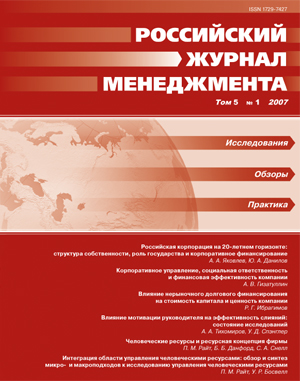CEO Motives and Merger Effectiveness: A State-of-the-field Review
Abstract
The article examines the integrated approach to studying the effectiveness of M&As, which remains an important issue in the area of strategic management and leadership. The focus of our analysis is on CEO motivation to M&As. The Leadership Motive Profile (LMP) theory is introduced as an approach to studying the genesis and functioning of noneconomic M&A motives at the individual CEO level of the acquiring company. We specify a set of hypotheses where merger effectiveness is conditioned by the type of the CEO’s motive profile. Finally, we discuss the future directions for studying CEO non-economic M&A motives.
Downloads
References
REFERENCES IN LATIN ALPHABET
Downloads
Published
How to Cite
Issue
Section
License
Articles of the Russian Management Journal are open access distributed under the terms of the License Agreement with Saint Petersburg State University, which permits to the authors unrestricted distribution and self-archiving free of charge.





